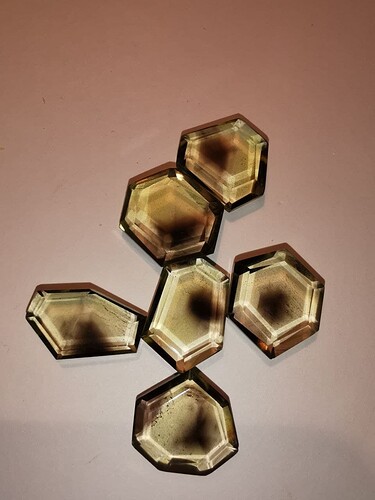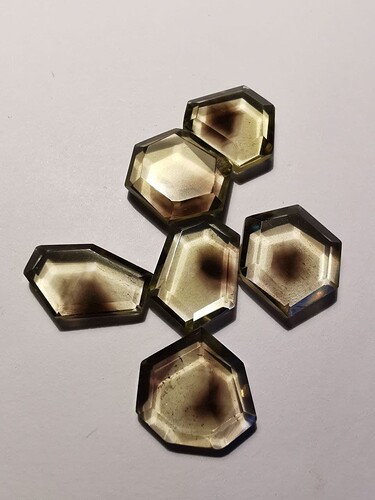Hello all,
I came across a lot of yellow-ish quartz, with some strange brown-ish hallow in them…;
I have researched a bit about different treatment on quartz and I couldn’t find any examples showcasing this type of effect. Does anybody has seen this before and who knows what type of treatment has been applied? I would guess it isn’t a natural color and effect…
Could they be cut versions of this?
https://joehenleyrough.com/products/bumblebee-quartz-22?_pos=2&_sid=7b6e8acff&_ss=r
I hold in stock a cut version of this quartz.
You have yellowish smokey quartz similar to cairngorm crystals of the Cairngorm Mountains of Scotland. Non-Scottish examples are marketed under the trade name “bumblebee.” The smoky color results from free silicon formed from the silicon dioxide by natural irradiation
Often times, smoky quartz can be turned into a citrine-like yellow through heat-treatment. With that being said, such heat treatments result in a significantly more vibrant product.
I would assess, with the above information, that these are likely natural.
Hi Dan, Thank you so much for your contribution! I know bumblebee jasper and most research ends up showing Jasper, but I am not sure this is the right term for this type of quartz? If you have any links and reads to it, I would love to have a look! Thank you 
Hi Robert-Alan, thank you so much for your response!
Such an interesting direction and I am much documenting myself on this Scottish quartz type. I agree that natural irridation must have played a role in creating this dark core, quite fuzzy and irregular. I’m more concerned that they have been irradiated in a lab to recreate this brown core…I wish they would have been sourced in the Cairngorm Mountains but I highly doubt this!
Its unlikely that there was any human radiation introduced to these samples. All examples of human radiated smokey quartz show vibrant yellow body color on par with lemon citrine and are typically sold as . Smokey quartz just do not have the market value, when compared to natural supply, to add any artificial enhancements. The cloudy “smoke” within the stone would actually serve to decrease the value of the stone. The more desirable, and more likely to be treated pieces would be clean stones without the halo. If these were to be enhanced, it would be to increase their over-all vibrancy.
Quartz is by and large one of the most common minerals in the Earth’s crust. As a result, they are often collected as a by-product of other mining activities. The only quartz that is directly, and intentionally mined are amethyst and ametrine since these are the more rare colors of quartz.
Clear and rose quartz are common enough, I can frequently find rough by walking across gravel parking lots.
As a note, smokey quartz ballpark between $3-5 per carat, and lemon quartz averages around $1.5 per carat. (source gemselect.com and a calculator.) Uniform body color is considered more desirable over color-zoning for cut specimens, while zoning is considered more desirable for uncut collector specimens.
So, if Amethyst and Citrine make Ametrine would Smoky and Citrine make Smitrine ?  Maybe they should stick to Bumblebee…
Maybe they should stick to Bumblebee…
Thank you so much for this thorough answer Robert-Alan.
As a supplier of all strange materials, I am pretty sure my contemporary jewelry designers will love the appearance of these slices with a dark core.

